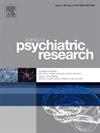Intergenerational effects of the Holocaust following the October 7 attack in Israel
IF 3.7
2区 医学
Q1 PSYCHIATRY
引用次数: 0
Abstract
Descendants of traumatized individuals may exhibit latent vulnerability, meaning they are typically well-functioning yet more vulnerable to stressful and traumatic events. Nevertheless, such vulnerability is not omnipresent, and some descendants are more prone than others to develop posttraumatic disorder (PTSD) and other psychopathologies. Ancestral PTSD was suggested as an aggravating factor for intergenerational effects. The current study examined whether Holocaust descendants (i.e., children and grandchildren of Holocaust survivors) show unique posttraumatic reactions to the October 7 terrorist attack and the ensuing war and whether parental/grandparental PTSD exacerbated these reactions. A web-based random sample of 582 Israeli Jews completed questionnaires a year before the October 7 terrorist attack (Wave 1, 2022) and two months after the attack and into the war (Wave 3, December 2023). Results showed that pre-war probable PTSD rates were similar across the study groups (10.4% and 11.5% among Holocaust descendants and descendants of those not directly exposed to the Holocaust, respectively). In contrast, probable PTSD rates during the war mainly increased among Holocaust descendants (20.9% and 11.5% among Holocaust and comparison descendants, respectively). Higher probable PTSD rates were especially noticeable in Wave 3 among Holocaust descendants who reported that their parents/grandparents had probable PTSD even after controlling Wave 1 probable PTSD, background characteristics, and levels of traumatic exposure. The findings have important implications for understanding the intergenerational effects of trauma as they strongly support the latent vulnerability hypothesis three generations after ancestral trauma, and further suggest that ancestral PTSD plays a major role in aggravating such vulnerability.
10月7日以色列袭击后大屠杀的代际影响。
受过创伤的人的后代可能会表现出潜在的脆弱性,这意味着他们通常功能良好,但更容易受到压力和创伤事件的影响。然而,这种脆弱性并非无处不在,一些后代比其他人更容易患上创伤后精神障碍(PTSD)和其他精神病理。祖源性创伤后应激障碍被认为是代际效应的加重因素。目前的研究调查了大屠杀后裔(即大屠杀幸存者的子女和孙辈)是否对10月7日的恐怖袭击和随后的战争表现出独特的创伤后反应,以及父母/祖父母的创伤后应激障碍是否加剧了这些反应。在10月7日恐怖袭击发生前一年(第一波,2022年)和袭击发生后两个月(第三波,2023年12月),582名以色列犹太人在网络上随机完成了问卷调查。结果显示,战前可能的创伤后应激障碍率在各研究组之间相似(大屠杀后裔和未直接接触大屠杀的后裔分别为10.4%和11.5%)。相比之下,战争期间可能的PTSD发病率主要在大屠杀后代中增加(大屠杀后代和比较后代分别为20.9%和11.5%)。在第三波大屠杀的后代中,即使在控制了第一波可能的创伤后应激障碍、背景特征和创伤暴露水平之后,他们的父母/祖父母也可能患有创伤后应激障碍。这一发现对理解创伤的代际效应具有重要意义,因为它们有力地支持了祖先创伤后三代的潜在脆弱性假说,并进一步表明祖先创伤后应激障碍在加剧这种脆弱性方面起着重要作用。
本文章由计算机程序翻译,如有差异,请以英文原文为准。
求助全文
约1分钟内获得全文
求助全文
来源期刊

Journal of psychiatric research
医学-精神病学
CiteScore
7.30
自引率
2.10%
发文量
622
审稿时长
130 days
期刊介绍:
Founded in 1961 to report on the latest work in psychiatry and cognate disciplines, the Journal of Psychiatric Research is dedicated to innovative and timely studies of four important areas of research:
(1) clinical studies of all disciplines relating to psychiatric illness, as well as normal human behaviour, including biochemical, physiological, genetic, environmental, social, psychological and epidemiological factors;
(2) basic studies pertaining to psychiatry in such fields as neuropsychopharmacology, neuroendocrinology, electrophysiology, genetics, experimental psychology and epidemiology;
(3) the growing application of clinical laboratory techniques in psychiatry, including imagery and spectroscopy of the brain, molecular biology and computer sciences;
 求助内容:
求助内容: 应助结果提醒方式:
应助结果提醒方式:


